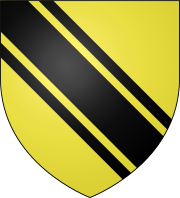| Earldom of Oxford and Earldom Mortimer | |
|---|---|
  Arms of Harley: Or, a bend cotised sable | |
| Creation date | 24 May 1711 |
| Created by | Queen Anne |
| Peerage | Peerage of Great Britain |
| First holder | Robert Harley |
| Last holder | Alfred Harley, 6th Earl of Oxford and Earl Mortimer |
| Remainder to | Heirs male of the first earl's body lawfully begotten; with special remainder to heirs male of his grandfather (Sir Robert Harley) failing heirs male[1] |
| Subsidiary titles | Baron Harley |
| Extinction date | 19 January 1853[2] |
| Former seat(s) | Brampton Bryan Hall Eywood House |
| Motto | Virtute et fide ("By virtue and faith")[1] |

Earl of Oxford and Earl Mortimer was a title in the Peerage of Great Britain. It was created in 1711 for the statesman Robert Harley, with remainder, failing heirs male of his body, to those of his grandfather, Sir Robert Harley. He was made Baron Harley, of Wigmore in the County of Hereford, at the same time, also in the Peerage of Great Britain and with similar remainder as for the earldom. Harley was the eldest son of Sir Edward Harley and the grandson of the aforementioned Sir Robert Harley.[1]
The style Earl of Oxford and Earl Mortimer was chosen because the ancient earldom of Oxford, held for many centuries by the de Vere family, had become dormant but not extinct in 1703, meaning a descendant could conceivably have stepped forward to claim his title. Harley claimed the Oxford title because of his relationship through marriage to the de Veres. Despite its form (unique in the history of the peerages of the British Isles), it was a single peerage.[3]
- ^ a b c Burke, John (1833). A General and Heraldic Dictionary of the Peerage and Baronetage of the British Empire. H. Colburn and R. Bentley. pp. 274–275. Retrieved 17 November 2016.
- ^ Burke, Sir Bernard (1866). A Genealogical History of the Dormant: Abeyant, Forfeited, and Extinct Peerages of the British Empire. Harrison. pp. 265–266.
- ^ "Past Earls of Oxford: A Title Laden With Traditions". The Times. 26 January 1925. p. 14.